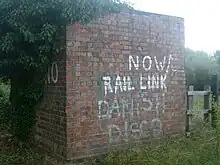Willington | |
|---|---|
| General information | |
| Location | Willington, Borough of Bedford England |
| Grid reference | TL113503 |
| Platforms | 2 |
| Other information | |
| Status | Disused |
| History | |
| Original company | London and North Western Railway |
| Post-grouping | London, Midland and Scottish Railway London Midland Region of British Railways (1948–1958) Eastern Region of British Railways (1958–1968) |
| Key dates | |
| 1 May 1903 | Opened |
| 13 July 1964[1] | Closed to goods |
| 1 January 1968[2] | Closed to passengers |
Willington was a railway station on the Varsity Line which served the small village of the same name in Bedfordshire. Opened in 1903, the station was located in a rural area and saw little passenger traffic; it closed together with the line in 1968.
History
Willington station only opened in 1903, some forty years after the Varsity Line had first opened, as a result of pressure by local villagers on the London and North Western Railway (LNWR).[3] Prior to the station's opening, there had been a siding on the site from September 1896 to handle local vegetable traffic, together with a weighing machine.[4] The station opened at a time when the railway company was looking to increase revenues on the line and was followed by the opening of five halts in 1905 at Wootton Broadmead, Kempston Hardwick, Kempston, Aspley Guise, Bow Brickhill and Husborne Crawley.[5]
The initial station was a very basic single platform structure with wooden weatherboarded outbuildings typical of the LNWR's construction techniques.[6] A second timber platform was added in August 1912 when an unusually long passing loop was laid through the station.[7] A short 16-lever type 5 LNWR signal box was sited on the down platform adjacent to a wooden passenger shelter. At first, trains did not stop at the station unless passengers wishing to join had announced their intention to station staff who would stop the train by signal; passengers wishing to alight had to give notice at the preceding station.[8] The long passing loop was made yet longer on 3 August 1916 to facilitate the increased wartime traffic on the line.[9]
Dwindling goods traffic coupled with the fact that the station served a relatively rural community - there were 204 residents in 1901, rising to 475 in 1961[10] - plus its slightly inconvenient siting to the north of Willington village, left the station susceptible to competition from the motor car.[11] The station eventually closed together with the Bedford & Cambridge-built section of the Varsity Line in 1968.
| Preceding station | Disused railways | Following station | ||
|---|---|---|---|---|
| Bedford St Johns | British Railways Varsity Line |
Blunham |
Present day
Station site

The wooden station buildings were derelict by 1971 and had been cleared away by 1975, leaving the remains of the original brick-built platform.[12] The trackbed through the station has been preserved as part of National Cycle Route 51.
Bedford Rowing Lake
In July 2006, Bedfordshire County Council approved the construction of the Bedford Rowing Lake for the purposes of the 2012 Olympic Games, a 2,300m lake which was proposed to straddle the railway trackbed, taking a 120-metre section out of the route and making any reinstatement as had been proposed by the East West Rail Consortium far more expensive.[13][14] The Labour government was criticised for its lack of support for the East West Rail Project and failure to safeguard the trackbed.[15] As of late 2021, the lake project has not gone ahead, but reinstatement of this part of the alignment is not under consideration by the East-West Rail project (which is instead proposing brand new alignments further north).[16]
References
- ↑ Clinker, C.R. (October 1978). Clinker's Register of Closed Passenger Stations and Goods Depots in England, Scotland and Wales 1830–1977. Bristol: Avon-AngliA Publications & Services. p. 149. ISBN 0-905466-19-5.
- ↑ Butt, R.V.J. (1995). The Directory of Railway Stations, Patrick Stephens Ltd, Sparkford, ISBN 1-85260-508-1, p. 251.
- ↑ Oppitz, Leslie (2000). Lost Railways of the Chilterns (Lost Railways Series). Newbury, Berkshire: Countryside Books. p. 144. ISBN 978-1-85306-643-6.
- ↑ Mitchell, V.; Smith, K. (February 2007). Bletchley to Cambridge featuring Bedford St. Johns. Midhurst, West Sussex: Middleton Press. p. plate XVII. ISBN 978-1-904474-94-4.
- ↑ Simpson, Bill (1981). Oxford to Cambridge Railway (Vol. 2). Poole, Dorset: Oxford Publishing Co. p. 91. ISBN 0-86093-121-8.
- ↑ Davies, R.; Grant, M.D. (1984). Forgotten Railways: Chilterns and Cotswolds. Newton Abbot, Devon: David St John Thomas. p. 120. ISBN 0-946537-07-0.
- ↑ Simpson, B., p. 93.
- ↑ Oppitz, L., p. 144.
- ↑ Simpson, B., p. 91.
- ↑ Mitchell, V. and Smith, K., plate XIX.
- ↑ Simpson, Bill (2000). The Oxford to Cambridge Railway: Forty Years On 1960–2000. Witney, Oxford: Lamplight Publications. p. 15. ISBN 1-899246-05-3.
- ↑ "Disused Stations". Subterranea Britannica.
- ↑ Bedford Today, "Rowing towards final lake decision", 16 July 2006.
- ↑ "A Bridge too Far" (PDF). Railwatch. Railfuture. October 2006.
- ↑ BBC News, "Concern over East-West rail link", 10 January 2007.
- ↑ East West Rail, "Bedford to Cambridge" publicity material for 2021 consultation
External links
 Media related to Willington (Bedfordshire) railway station at Wikimedia Commons
Media related to Willington (Bedfordshire) railway station at Wikimedia Commons- "Disused Stations". Subterranea Britannica.
- Willington station on navigable 1946 O.S. map